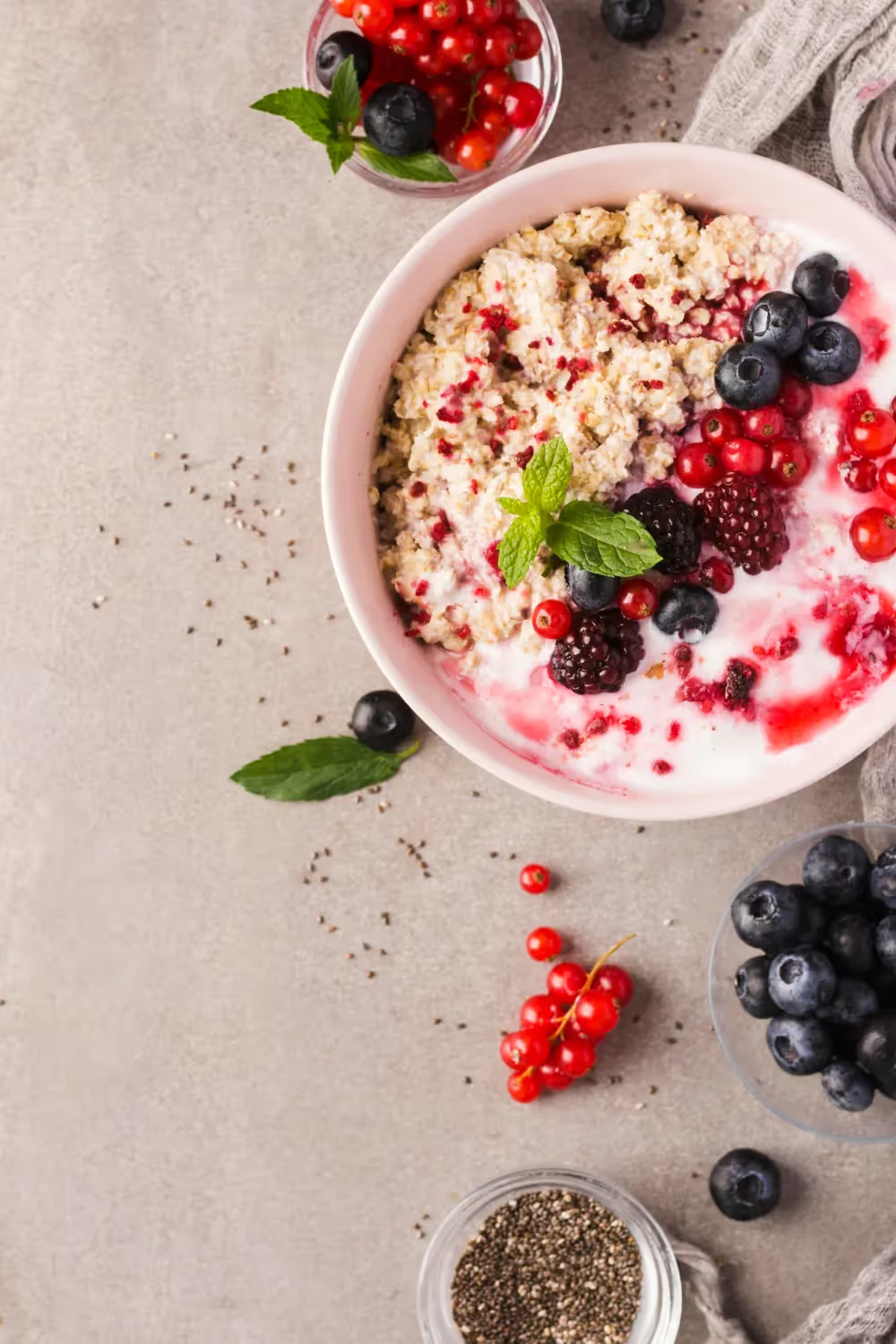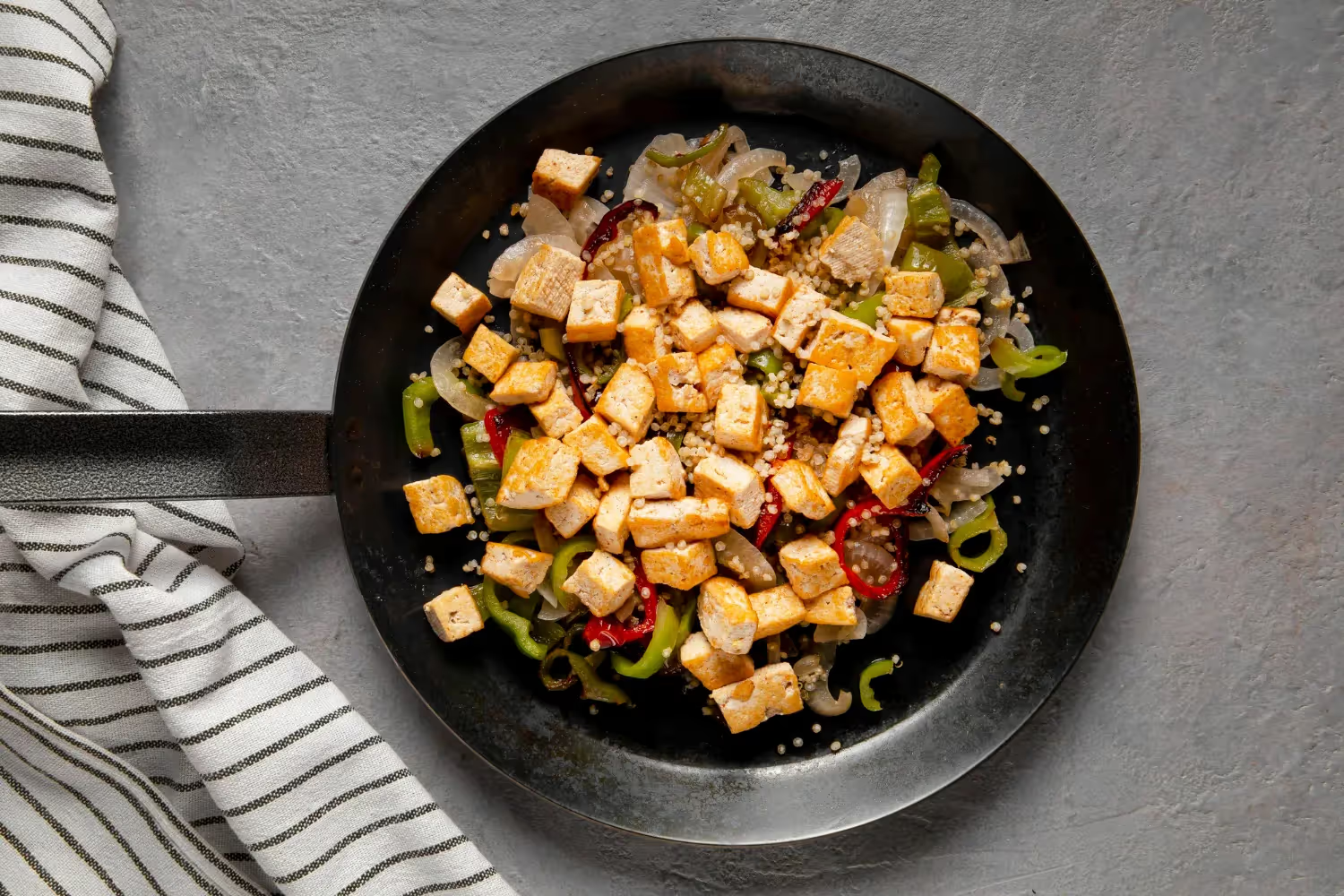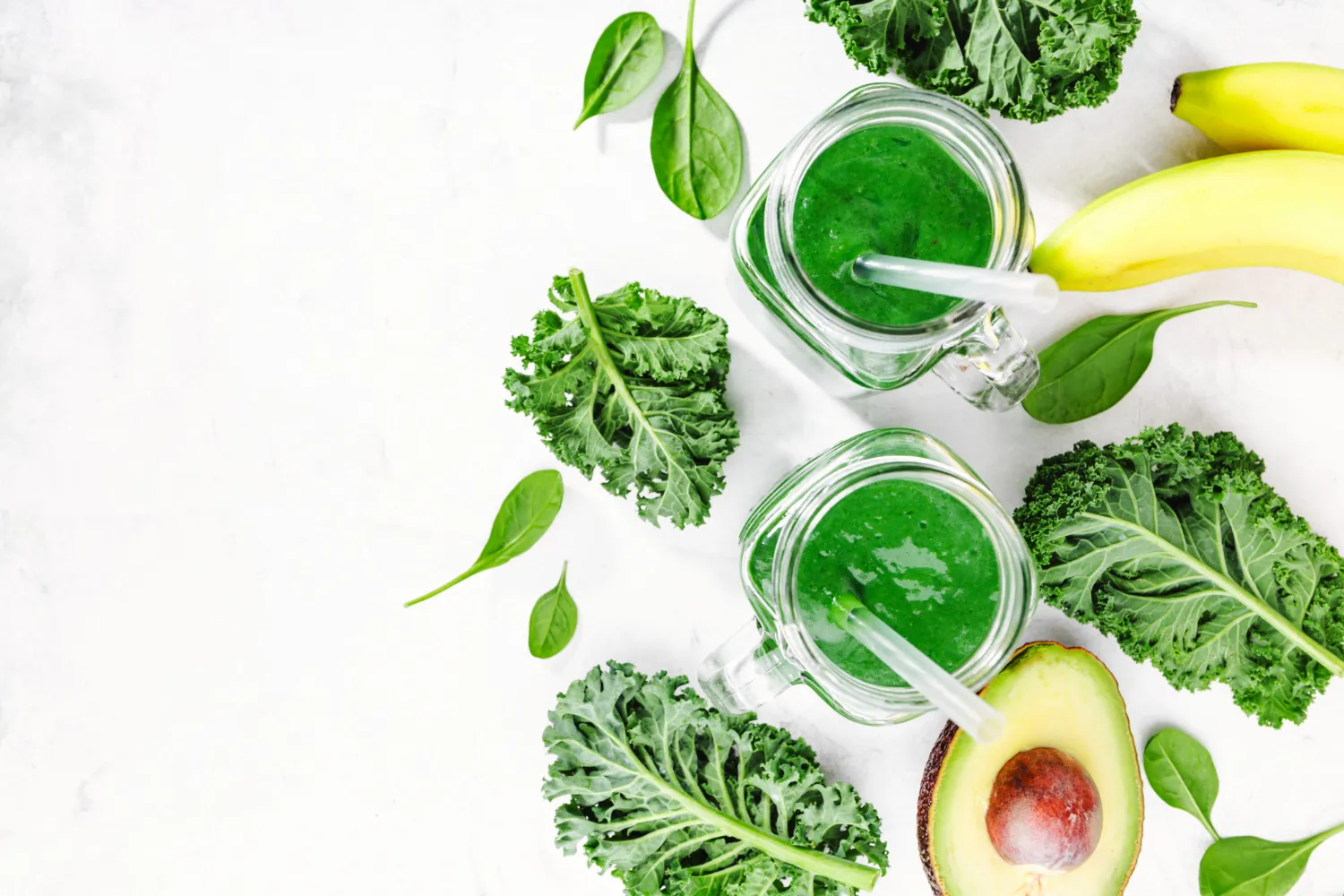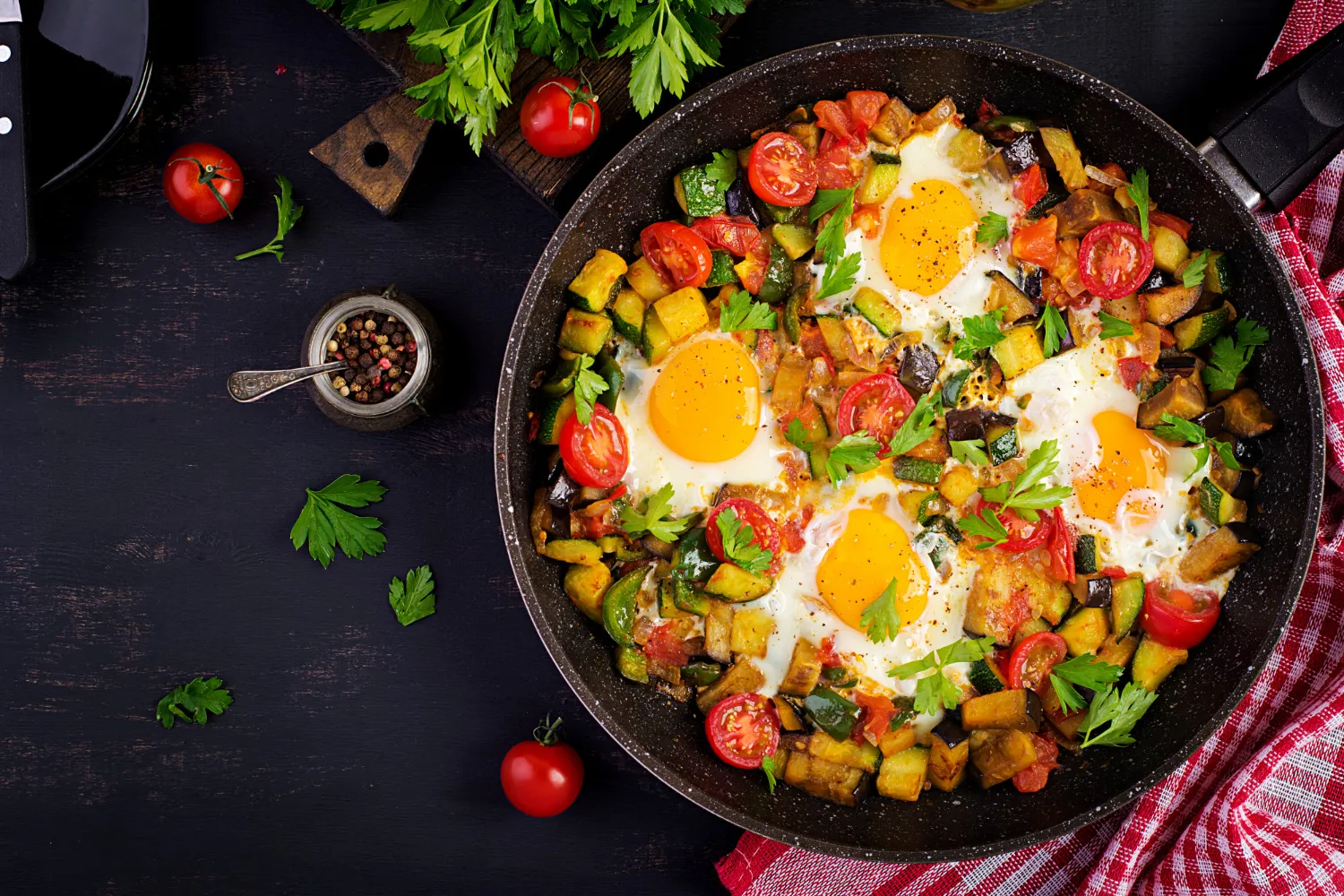Over the past decade, no-meat, plant-based diets have risen in popularity, with sources highlighting a 500% increase from 2014 to 2017 in the U.S. alone.
Sources show the global plant-based market is set to expand from USD 7.17 billion in 2023, with projects reaching USD 24.77 billion in 2030. Astounding figures don’t even account for the semi-vegan market.
For women in midlife, this becomes an enticing transition with improved digestion, heart health, and hormonal balance.
In this article, we discuss the 7-day no-meat diet for women. We discuss why many are moving to no-meat over 40, key nutrients to prioritize, and smart meatless swaps for everyday meals.
Why Many Women Over 40 Are Choosing a No-Meat Diet

For women, entering the 40s can come with serious physiological curve balls. During this time, the reproductive hormone estrogen declines, leading to menopause.
Research shows this leads to symptoms such as hot flashes, night sweats, mood changes, sleep disturbances, bone loss, impaired cognitive function, gut issues, increased appetite, and change in fat distribution.
Studies show that weight gain is experienced by 60–70% of middle-aged-women, who gain 6.8 kg per year between the ages of 50–60.
Body fat surrounding the abdomen in particular is a concern as it increases the risk of chronic illnesses such as type 2 diabetes, cardiovascular disease, and cancer.
Women over 40 choose the no-meat diet because of its health benefits, which can alleviate these symptoms, and enhance energy levels.
Sources indicate that plant-based diets are associated with a lower risk of chronic illnesses including obesity, type 2 diabetes, cardiovascular disease, and cancer.
The no-meat diet consists of nutrient-dense complex carbohydrates and healthy fats. Research indicates complex carbohydrates take longer to digest, leading to a gradual increase in blood sugar, helping to regulate insulin while reducing hunger.
Furthermore, they can contain fiber, which has been shown to lower blood cholesterol, improve regularity, and regulate blood glucose levels after meals.
Meanwhile, healthy fats have been shown to decrease inflammation, protect organs, and reduce the risk of chronic diseases such as cardiovascular diseases and cancer.
Combined, these benefits stabilize energy levels and improve fullness, aiding in weight loss, while reducing the risk of chronic illness and addressing several age and menopause-related symptoms.
Key Nutrients to Prioritize Without Meat
One of the biggest issues with the no-meat diet is that there is a risk of nutrient deficiency. Below is a list of key nutrients to prioritize to keep you in good health during your no-meat diet.
Your 7-Day No Meat Diet Plan
The following no-meat diet plan consists of four meals each day, with a focus on consuming nutrient-dense whole foods, supporting gut, heart, and hormonal health.
Each ingredient is listed with calorie content, and meals contain a description of the benefits to tell you exactly what it is doing for your body.
Below we have listed the recommended calorie and macronutrient intake. Below we list the formula to calculate the basal metabolic rate (BMR) to identify the calorie allowance.
BMR Formula
- BMR = 10 x weight (kg) + 6.25 x height (cm) - 5 x age (years) -161
Using this formula, we will calculate the BMR for the 46-year-old woman, who is 165 cm tall and weighs 70 kg.
- 10 x 70 + 6.25 x 170 - 5 x 42 - 161 =
- 700 + 1062.5 - 210 - 161 = 1391.5 kcal/day
Below is the macronutrient ratio for this no-meat diet.
- Carbohydrates: 50% of daily calorie intake
- Protein: 20% of daily calorie intake
- Fats: 30% of daily calorie intake
Using this information we have divided calories between the four meals for each day.
Day 1 — Legumes and Leafy Greens for Iron
Breakfast: Iron-Rich Chickpea & Spinach Hash (400 kcal)
Ingredients
- ½ cup cooked chickpeas (134 kcal)
- 1 cup sautéed spinach (40 kcal)
- ½ cup diced sweet potato (90 kcal)
- 1 tbsp olive oil (119 kcal)
- ¼ avocado, sliced (57 kcal)
- 1 tbsp chopped red onion (4 kcal)
- ½ tsp cumin (2 kcal)
- Lemon juice, salt, pepper (~0 kcal)
Benefits: This hearty hash supports cholesterol reduction with soluble fiber, plant sterols, and healthy fats from avocado and olive oil.
Lunch: Lentil & Quinoa Bowl with Tahini Dressing (400 kcal)
Ingredients
- ½ cup cooked green lentils (115 kcal)
- ½ cup cooked quinoa (111 kcal)
- 1 cup chopped kale (lightly steamed) (36 kcal)
- 1 tbsp tahini (89 kcal)
- 1 tsp olive oil (40 kcal)
- ¼ cup shredded carrot (12 kcal)
- 1 tbsp pumpkin seeds (57 kcal)
- 1 tsp lemon juice, garlic powder, salt, pepper (~0 kcal)
Benefits: Lentils, kale, and tahini provide iron and fiber to enhance blood health and reduce LDL cholesterol.
Dinner: White Bean & Greens Stew with Barley (400 kcal)
Ingredients
- ½ cup cooked white beans (125 kcal)
- ½ cup cooked pearl barley (97 kcal)
- 1 cup chopped kale (or spinach), cooked (36 kcal)
- ½ cup diced tomatoes (15 kcal)
- ½ cup vegetable broth (low sodium) (7 kcal)
- 1 tsp olive oil (40 kcal)
- ¼ cup chopped onion (16 kcal)
- 1 clove garlic (5 kcal)
- Spices (thyme, paprika, black pepper) (~0 kcal)
Benefits: Barley and white beans provide beta-glucan and resistant starches, which help control blood sugar and lower cholesterol.
Snack: Apple & Nut Butter with Hemp Seeds (~192 kcal)
Ingredients
- 1 medium apple (95 kcal)
- 1 tbsp almond butter (98 kcal)
- 1 tsp hemp seeds (14 kcal)
Benefits: Apples contain pectin, a soluble fiber that binds cholesterol in the digestive tract, while almond butter and hemp seeds add healthy fats and plant protein.
Day 2 — Complete Proteins with Grains and Seeds

Breakfast: Quinoa-Chia Porridge with Almond Butter & Berries (400 kcal)
Ingredients
- ½ cup cooked quinoa (111 kcal)
- 1 tbsp chia seeds (58 kcal)
- ½ cup unsweetened almond milk (15 kcal)
- 1 tbsp almond butter (98 kcal)
- ½ cup blueberries (42 kcal)
- 1 tsp maple syrup (17 kcal)
- ½ tsp cinnamon (0 kcal)
- 1 tbsp hemp seeds (59 kcal)
Benefits: This fiber- and omega-3-rich breakfast supports heart health, with chia and hemp seeds helping to reduce LDL cholesterol and inflammation.
Lunch: Tofu, Quinoa & Seed Salad with Lemon-Tahini Dressing (400 kcal)
Ingredients
- ½ cup cooked quinoa (111 kcal)
- ½ cup firm tofu, cubed (94 kcal)
- 1 cup chopped spinach (7 kcal)
- ¼ avocado (57 kcal)
- 1 tbsp tahini (89 kcal)
- 1 tbsp sunflower seeds (51 kcal)
- 1 tsp lemon juice, garlic powder (~0 kcal)
Benefits: The combination of tofu, quinoa, and seeds provides complete proteins and heart-healthy fats that help lower cholesterol and support metabolic health.
Dinner: Lentil-Stuffed Sweet Potato with Tahini Drizzle (400 kcal)
Ingredients
- 1 medium baked sweet potato (112 kcal)
- ½ cup cooked lentils (115 kcal)
- 1 tbsp tahini (89 kcal)
- ½ cup steamed kale (18 kcal)
- 1 tsp olive oil (40 kcal)
- 1 tbsp hemp seeds (59 kcal)
Benefits: Lentils and tahini deliver fiber and plant sterols that help remove excess cholesterol, while sweet potato adds resistant starch for blood sugar balance.
Snack: Protein Bites with Oats, Peanut Butter & Seeds (~192 kcal)
Ingredients
- 2 tbsp rolled oats (76 kcal)
- 1 tbsp natural peanut butter (94 kcal)
- 1 tsp chia seeds (20 kcal)
- Dash of cinnamon and vanilla (~2 kcal)
Benefits: This snack is rich in soluble fiber and plant-based protein, supporting healthy cholesterol and keeping hunger at bay between meals.
Day 3 — Gut-Friendly Fiber and Ferments
Breakfast: Miso Oats with Berries & Seeds (400 kcal)
Ingredients
- ½ cup rolled oats (cooked in water) (150 kcal)
- 1 tsp white miso paste (stirred in post-cooking) (10 kcal)
- ½ cup blueberries (42 kcal)
- 1 tbsp ground flaxseed (37 kcal)
- 1 tbsp almond butter (98 kcal)
- 1 tbsp hemp seeds (59 kcal)
- Dash of cinnamon (~0 kcal)
Benefits: The oats, flaxseed, and berries offer soluble fiber and polyphenols that support cholesterol balance, while miso adds natural probiotics to enhance gut flora.
Lunch: Tempeh & Kimchi Grain Bowl (400 kcal)
Ingredients
- ½ cup cooked brown rice (109 kcal)
- ½ cup tempeh, sautéed (166 kcal)
- ¼ avocado (57 kcal)
- ¼ cup kimchi (10 kcal)
- ½ cup shredded red cabbage (12 kcal)
- 1 tsp sesame oil (40 kcal)
- 1 tbsp chopped scallions (6 kcal)
Benefits: Fermented kimchi and fiber-rich cabbage promote gut motility and introduce beneficial bacteria, while tempeh offers fermented protein and soy isoflavones that may help lower LDL cholesterol.
Dinner: Lentil Soup with Sauerkraut Garnish (400 kcal)
Ingredients
- ½ cup cooked green lentils (115 kcal)
- ½ cup diced carrots (26 kcal)
- ¼ cup chopped onion (16 kcal)
- 1 cup chopped kale (36 kcal)
- ½ cup low-sodium vegetable broth (7 kcal)
- 1 tsp olive oil (40 kcal)
- 1 tbsp sauerkraut (added at serving) (5 kcal)
- ½ cup cooked barley (98 kcal)
- Garlic, thyme, black pepper (~0 kcal)
Benefits: Lentils and barley provide soluble fiber and prebiotics for gut and heart health, while a spoonful of raw sauerkraut adds probiotics that enhance digestion and nutrient absorption.
Snack: Kefir Smoothie with Banana & Chia (~192 kcal)
Ingredients:
- ¾ cup plain unsweetened kefir (90 kcal)
- ½ banana (45 kcal)
- 1 tsp chia seeds (20 kcal)
- 1 tbsp rolled oats (19 kcal)
- Dash cinnamon (~0 kcal)
- 1 ice cube (blended in) (0 kcal)
Benefits: Kefir provides a powerful dose of probiotics, while oats, bananas, and chia contribute fermentable fiber that supports beneficial gut bacteria and helps lower cholesterol.
Day 4 — Mediterranean Plant-Powered Day
Breakfast: Mediterranean Chickpea & Tomato Toast with Olives (~400 kcal)
Ingredients
- 1 slice whole grain bread (100 kcal)
- ½ cup cooked chickpeas (134 kcal)
- ¼ cup cherry tomatoes (8 kcal)
- 1 tsp olive oil (40 kcal)
- 1 tbsp chopped kalamata olives (40 kcal)
- 1 tbsp hummus (35 kcal)
- 1 tbsp chopped parsley (2 kcal)
- Squeeze of lemon juice, pinch of cumin, salt (~0 kcal)
Benefits: Chickpeas, olives, and whole grains deliver soluble fiber and plant sterols that promote heart health and reduce LDL cholesterol.
Lunch: Farro & Lentil Salad with Lemon-Olive Dressing (~400 kcal)
Ingredients
- ½ cup cooked farro (100 kcal)
- ½ cup cooked green lentils (115 kcal)
- 1 cup arugula or spinach (7 kcal)
- ¼ avocado (57 kcal)
- 1 tbsp chopped olives (40 kcal)
- 1 tsp olive oil (40 kcal)
- 1 tbsp red onion, lemon juice, oregano (~5 kcal)
Benefits: Lentils and farro provide gut-loving prebiotic fiber, while olive oil and avocado supply healthy monounsaturated fats that help lower cholesterol.
Dinner: Mediterranean Stuffed Peppers with White Beans & Herbs (~400 kcal)
Ingredients:
- 1 large bell pepper (stuffed) (45 kcal)
- ½ cup cooked white beans (125 kcal)
- ½ cup cooked brown rice (109 kcal)
- 1 tbsp pine nuts (45 kcal)
- 1 tsp olive oil (40 kcal)
- 1 tbsp chopped sundried tomatoes (20 kcal)
- Chopped parsley, garlic, lemon zest (~10 kcal)
Benefits: This hearty dinner offers fiber and plant protein from beans and rice, plus pine nuts and olive oil that contribute to a healthy cholesterol balance.
Snack: Yogurt, Figs & Walnuts Bowl (~192 kcal)
Ingredients:
- ½ cup plain unsweetened Greek-style plant yogurt – 90 kcal
- 1 medium fresh fig (or 2 dried halves) – 37 kcal
- 1 tbsp chopped walnuts – 45 kcal
- 1 tsp chia seeds – 20 kcal
Benefits: Yogurt and chia nourish your gut microbiome, while walnuts offer omega-3s and polyphenols shown to reduce total and LDL cholesterol.
Day 5 — Meat-Free Protein Boost with Tofu and Beans

Breakfast: Savory Tofu & Black Bean Breakfast Bowl (~400 kcal)
Ingredients & Calories:
- ½ cup cooked black beans (114 kcal)
- ⅓ block (100g) firm tofu, pan-seared (94 kcal)
- ½ cup cooked quinoa (111 kcal)
- 1 tsp olive oil (40 kcal)
- ¼ avocado (57 kcal)
- Sprinkle of paprika, garlic powder, and lime juice (~0 kcal)
Benefits: This protein-packed breakfast supports healthy cholesterol levels through fiber-rich beans, plant sterols, and heart-healthy fats from avocado and olive oil.
Lunch: Quinoa & Bean Salad with Tofu Croutons (~400 kcal)
Ingredients:
- ½ cup cooked quinoa (111 kcal)
- ½ cup cooked cannellini beans (112 kcal)
- ⅓ block (100g) crispy baked tofu (94 kcal)
- 1 cup mixed greens (7 kcal)
- 1 tsp olive oil (40 kcal)
- 1 tbsp lemon juice, parsley, and black pepper (~0 kcal)
Benefits: Quinoa and beans provide complete protein and soluble fiber, while tofu and olive oil contribute to LDL-cholesterol lowering and satiety.
Dinner: Tofu & Three-Bean Chili (~400 kcal)
Ingredients:
- ¼ cup each of black beans, kidney beans, and pinto beans (171 kcal)
- ⅓ block (100g) tofu, cubed (94 kcal)
- ½ cup diced tomatoes (15 kcal)
- ½ cup cooked brown rice (109 kcal)
- 1 tsp olive oil (40 kcal)
- Onion, garlic, cumin, chili powder (~0 kcal)
Benefits: This hearty chili is rich in soluble fiber and plant compounds that reduce cholesterol absorption and improve gut and heart health.
Snack: Chocolate Tofu Pudding with Banana Slices (~192 kcal)
Ingredients:
- ⅓ cup silken tofu (55 kcal)
- 1 tsp cocoa powder (5 kcal)
- ½ banana, sliced (45 kcal)
- 1 tsp maple syrup (17 kcal)
- 1 tsp chia seeds (20 kcal)
- 1 tbsp rolled oats (19 kcal)
- Splash vanilla extract & cinnamon (~0 kcal)
Benefits: Silken tofu and chia add protein and fiber, supporting cholesterol reduction, while banana and oats offer gut-friendly resistant starch and beta-glucan.
Day 6 — Anti-Inflammatory, Low-Glycemic Focus
Breakfast: Cinnamon-Spiced Quinoa Bowl with Berries & Walnuts (~400 kcal)
Ingredients:
- ½ cup cooked quinoa (111 kcal)
- ½ cup unsweetened almond milk (15 kcal)
- ½ cup blueberries (42 kcal)
- 1 tbsp ground flaxseed (37 kcal)
- 1 tbsp chopped walnuts (45 kcal)
- 1 tbsp almond butter (98 kcal)
- ½ tsp cinnamon & dash of vanilla (~0 kcal)
- Optional: Stevia or monk fruit for sweetness (0 kcal)
Benefits: Quinoa, flaxseed, and berries offer soluble fiber and polyphenols that lower LDL cholesterol and stabilize blood sugar.
Lunch: Lentil & Roasted Veggie Bowl with Tahini-Lemon Dressing (~400 kcal)
Ingredients:
- ½ cup cooked green lentils (115 kcal)
- ½ cup roasted sweet potato (90 kcal)
- ½ cup steamed broccoli (27 kcal)
- 1 tbsp tahini (90 kcal)
- 1 tsp olive oil –40 kcal
- 1 cup spinach or arugula – 7 kcal
- Lemon juice, turmeric, black pepper, garlic (~0 kcal)
Benefits: Lentils and broccoli are rich in anti-inflammatory fiber and plant sterols, while tahini and olive oil provide cholesterol-lowering unsaturated fats.
Tofu & Wild Rice Stir-Fry with Greens & Ginger (~400 kcal)
Ingredients:
- ⅓ block (100g) extra-firm tofu (94 kcal)
- ½ cup cooked wild rice (83 kcal)
- ½ cup sautéed kale (18 kcal)
- ¼ cup sliced red bell pepper (12 kcal)
- 1 tsp sesame oil (40 kcal)
- 1 tbsp chopped almonds (45 kcal)
- Garlic, fresh grated ginger, tamari (low-sodium) (~0 kcal)
Benefits: Tofu, wild rice, and kale are high in anti-inflammatory nutrients and fiber, supporting cholesterol management and stable blood sugar.
Snack: Chia-Cacao Pudding with Berries (~192 kcal)
Ingredients:
- 2 tbsp chia seeds – 120 kcal
- ½ cup unsweetened almond milk – 15 kcal
- ½ tsp raw cacao powder – 5 kcal
- ½ cup strawberries – 24 kcal
- 1 tsp maple syrup or monk fruit – 12 kcal
- 1 tbsp hemp seeds – 16 kcal
Benefits: Chia and hemp seeds are loaded with omega-3s and fiber, helping lower LDL and C-reactive protein (CRP), a marker of inflammation.
Day 7 — High-Energy Wrap-Up with Nutrient Variety
Breakfast: Energizing Oat Bowl with Almond Butter, Banana & Pumpkin Seeds (~400 kcal)
Ingredients:
- ½ cup rolled oats (cooked) – 154 kcal
- ½ banana, sliced – 45 kcal
- 1 tbsp almond butter – 98 kcal
- 1 tbsp pumpkin seeds – 60 kcal
- 1 tsp chia seeds – 20 kcal
- Dash of cinnamon, sea salt, water – ~0 kcal
Benefits: Oats, nuts, and seeds deliver plant sterols, fiber, and healthy fats that work together to support energy while helping to lower LDL cholesterol.
Lunch: Sweet Potato Chickpea Bowl with Greens & Tahini Drizzle (~400 kcal)
Ingredients:
- ½ cup roasted sweet potato cubes (90 kcal)
- ½ cup cooked chickpeas (134 kcal)
- 1 cup arugula or spinach (7 kcal)
- 1 tbsp tahini (90 kcal)
- 1 tsp olive oil (40 kcal)
- Sprinkle of lemon juice, paprika, cumin (~0 kcal)
Benefits: Chickpeas and sweet potato are high in soluble fiber and resistant starch, supporting cholesterol reduction and sustained energy release.
Dinner: Lentil & Quinoa Stir-Fry with Roasted Veggies & Hemp Seeds (~400 kcal)
Ingredients:
- ½ cup cooked green lentils (115 kcal)
- ½ cup cooked quinoa (111 kcal)
- ½ cup roasted zucchini and bell pepper (40 kcal)
- 1 tsp olive oil (40 kcal)
- 1 tbsp hemp seeds (57 kcal)
- Garlic, herbs, black pepper (~0 kcal)
Benefits: Lentils and hemp seeds supply complete plant protein and omega-3s, both of which improve cholesterol balance and combat fatigue.
Snack: Dark Chocolate Date & Nut Bites (~192 kcal)
Ingredients:
- 2 Medjool dates (132 kcal)
- 1 tbsp crushed walnuts (45 kcal)
- 1 tsp dark chocolate chips (15 kcal)
- Sprinkle of sea salt and cinnamon (~0 kcal)
Benefits: Dates, nuts, and dark chocolate are rich in polyphenols and soluble fiber, which help reduce LDL cholesterol and provide steady energy.
Smart Meatless Swaps for Everyday Meals

No meat does have to mean no flavor. Below, we highlight smart meatless swaps for everyday meals to add texture, flavor, and variety to your meals.
Replacing Ground Meat, Chicken, or Fish Without Sacrificing Flavor
Replacing meat can be challenging as it needs to meet the requirements for texture, flavor, and nutrient density. Several options are commonly used, however, some may need a little help meeting those nutrient needs.
Below is a list of replacement foods, including a description of their sources, texture, and nutrients. Consider combining these with marinade and spices to enhance flavor.
Tips for Cooking with Plant-Based Proteins
Like meat, there are several ways you can cook your plant-based proteins to enhance texture and flavor. Here is a list of things to consider when cooking plant-based proteins.
- Marinating and Seasoning: Like meat, it can enhance flavor, or add a meaty taste.
- Pressing Tofu: Removes excess water and improves absorption of marinades.
- Texture: Pan or air-fry provides a crispy, browned, or caramelized texture.
- Avoid Overcooking: Helps to retain moisture and avoid drying out.
- Choose The Correct Meat For Each Meal: Tofu is versatile, tempeh is good for stir-fries, seitan mimics chicken and beef, and jackfruit has a pulled pork texture.
Building Satiety with Fiber and Healthy Fats
Protein is considered the most filling macronutrient. However, when meat, the largest source of protein, is removed from our diet it can make meals less filling, which can increase hunger and excess calorie consumption.
To avoid this, fiber and healthy fats can be prioritized to make up for this deficit. Fortunately, plant-based foods such as avocado, berries, sweet potato, and other fruits and vegetables are high in fiber. These will help slow digestion, making you feel fuller for longer.
Meanwhile, foods containing healthy fats such as avocado, nuts, flax seeds, chia seeds, soy, and tofu further improve satiety. Combined with high-protein plant-based food sources can boost fullness, leading to greater calorie control.
Recap — What a No-Meat Diet Can Do for You
The no-meat diet is a great way to expand your nutrition and reset your diet, and with an ever-expanding plant-based food market, going meat-free has never been easier.
Energy, Digestion, and Longevity
The no-meat diet is built on nutrient-dense whole foods which stabilize blood sugar and enhance satiety. For many, this can improve digestion, reduce chronic disease, and provide a surprising boost of energy.
While plant-based foods are typically nutrient-dense, each meal must contain adequate protein, fiber, and healthy fats to ensure these benefits and improve sustainability.
Nutrient-Rich Alternatives to Traditional Diets
Removing meat from your diet has its benefits, however, this does create gaps in nutrition which must be addressed. Below is a short list of nutrient-rich alternatives to support the no-meat diet.
- Protein: Foods including legumes, soy (tofu, tempeh), nuts, seeds, grains (oats, quinoa), and seitan are loaded with protein and nutrients.
- Fortified Foods: Plant-based milk, cereal, and other products contain vitamins B12, D, A, and E, and other nutrients that may be missing when meat intake is reduced.
- Omega-3: No fatty fish can lead to decreased omega-3. Fortunately, flaxseeds, chia seeds, and walnuts are incredible sources.
Supporting Hormones Through Plants
For women over 40, hormone support is vital for combating the decline of estrogen. It helps to maintain energy levels, bone density, cardiovascular health, mental health, and weight.
Foods containing healthy fats such as avocado, nuts, and seeds support hormone production and the absorption of fat-soluble vitamins.
High-fiber foods including legumes, whole grains, vegetables, and fruit can improve gut microbiome, which leads to better hormone balance.
Meanwhile, leafy greens and cruciferous vegetables are loaded with vitamins, minerals, and antioxidants, to support hormone regulation.
Sources
- Alcorta A, Porta A, Tárrega A, Alvarez MD, Vaquero MP. Foods for Plant-Based Diets: Challenges and Innovations. Foods. 2021 Feb 1;10(2):293. doi: 10.3390/foods10020293. PMID: 33535684; PMCID: PMC7912826. https://pmc.ncbi.nlm.nih.gov/articles/PMC7912826/
- Grand View Research, 2024. Plant-based meat market size, share & trends analysis report by source (soy, pea, wheat), by product, by type (chicken, pork, beef, fish, others), by end-use, by storage, by region, and segment forecasts, 2024–2030. Report ID: GVR-4-68039-145-9. [online] Grand View Research. https://www.grandviewresearch.com/industry-analysis/plant-based-meat-market
- Santoro N, Epperson CN, Mathews SB. Menopausal Symptoms and Their Management. Endocrinol Metab Clin North Am. 2015 Sep;44(3):497-515. doi: 10.1016/j.ecl.2015.05.001. PMID: 26316239; PMCID: PMC4890704. https://pmc.ncbi.nlm.nih.gov/articles/PMC4890704/
- Erdélyi A, Pálfi E, Tűű L, Nas K, Szűcs Z, Török M, Jakab A, Várbíró S. The Importance of Nutrition in Menopause and Perimenopause-A Review. Nutrients. 2023 Dec 21;16(1):27. doi: 10.3390/nu16010027. PMID: 38201856; PMCID: PMC10780928. https://pmc.ncbi.nlm.nih.gov/articles/PMC10780928/
- Hemler, E.C. and Hu, F.B., 2019. Plant-based diets for personal, population, and planetary health. Advances in Nutrition, 10(Suppl. 4), pp.S275–S283. https://www.sciencedirect.com/science/article/pii/S2161831322002150
- Holesh JE, Aslam S, Martin A. Physiology, Carbohydrates. 2023 May 12. In: StatPearls [Internet]. Treasure Island (FL): StatPearls Publishing; 2025 Jan–. PMID: 29083823. https://pubmed.ncbi.nlm.nih.gov/29083823/
- National Institutes of Health (NIH) Office of Dietary Supplements, 2023. Omega-3 fatty acids: Fact sheet for health professionals. [online] Office of Dietary Supplements. https://ods.od.nih.gov/factsheets/Omega3FattyAcids-HealthProfessional/
FAQs
How will I get enough protein without eating meat?
This is a top concern, and we've got you covered! Our 7-day plan is rich in high-quality plant-based protein sources like beans, lentils, chickpeas, tofu, quinoa, nuts, and seeds. The meal plan is specifically designed to ensure you meet your daily protein needs while staying satisfied.
Will I lose weight on this 7-day no meat diet?
While many people experience some weight loss due to a natural reduction in calories and an increase in fiber, this plan is best viewed as a "reset." Its main goals are to reduce bloating, improve digestion, and introduce you to healthier eating patterns that can support long-term weight management.
Is this diet complicated or expensive to follow?
Not at all. The meal plan is built around simple, easy-to-find ingredients that are often more budget-friendly than meat, like beans, lentils, seasonal vegetables, and whole grains. The recipes are designed for beginners and don't require complicated cooking skills.
What are the main benefits of a no-meat diet for women?
Plant-focused diets can be particularly beneficial for women. They are typically high in fiber, which aids in digestive health and hormone regulation. They are also rich in antioxidants and vitamins that can improve skin health and boost energy levels.
What should I do after the 7 days are over?
This 7-day plan is a fantastic stepping stone. Afterwards, you can choose to continue with a fully meat-free lifestyle, or you can use what you've learned to incorporate more plant-based meals into your week (like "Meatless Mondays"). The goal is to build sustainable, healthy habits that work for you.















